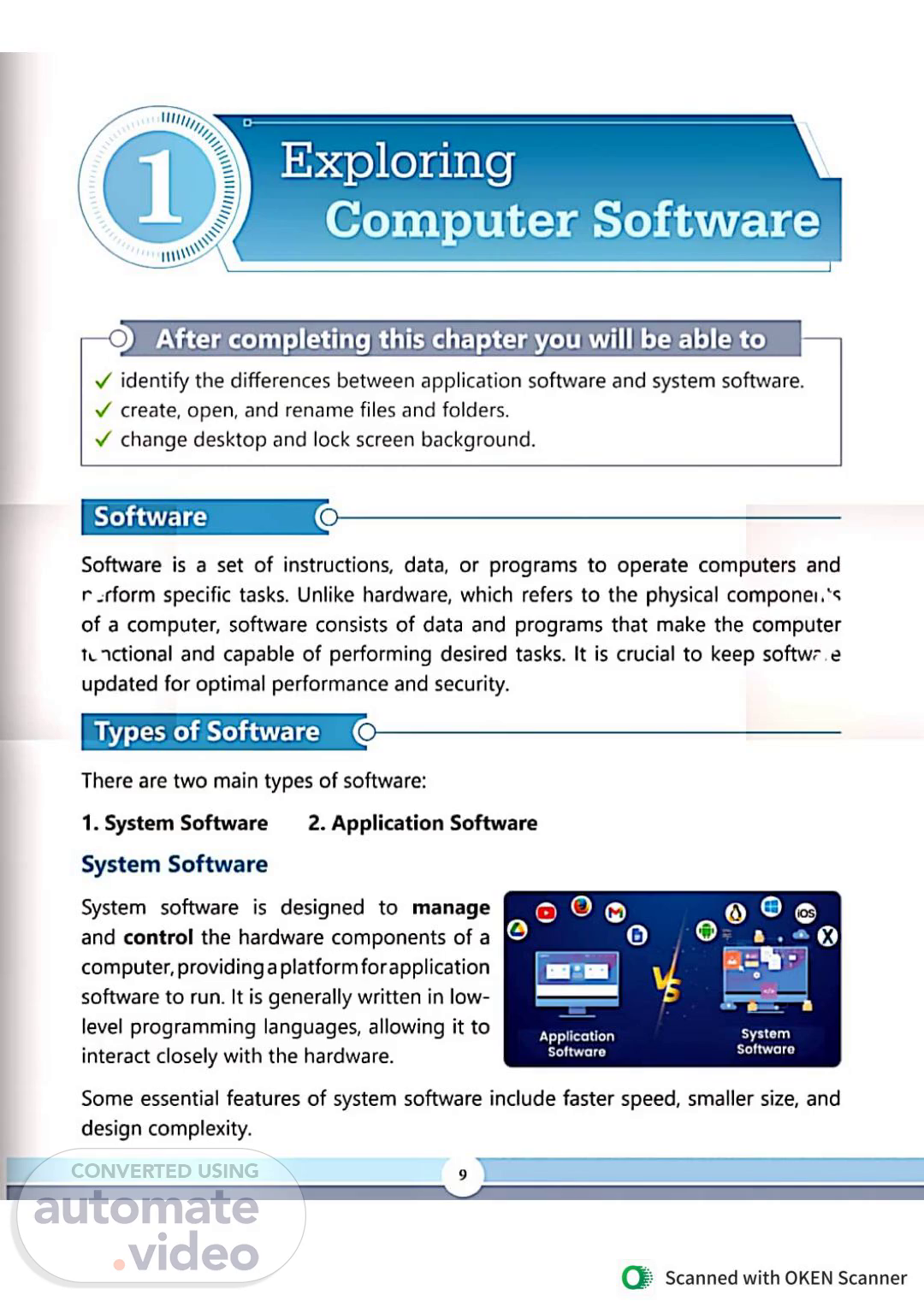Scene 2 (5s)
Key examples of system software are: Operating System BIOS Device Drivers Utilities Acts as an interface between the user and the computer hardware, managing and coordinating activities. Examples include Windows, macOS, and Linux. Basic Input Output System stored in ROM. It is responsible for booting up the computer and loading the operating system into memory. Software that controls hardware devices connected to the computer, such as printer drivers and sound card drivers. Programs designed to help manage, maintain, and control computer resources, such as antivirus software and disk management tools. Application Software Application software is designed to help users perform specific tasks or activities. l' dike system software, application software is closer to the user, more interactiv 4, and typically written in high-level languages like Python. i INFO A high-level language (HLL) is a programming language, designed to simplify computer programming and make it more accessible to humans. Examples of application software include: Word Processing Used for creating and editing text documents. For example, Software Spreadsheet Software Multimedia Software Database Software Web Browsers Microsoft Word. Used for organising data and performing calculations. For example, Microsoft Excel. Used for creating and editing audio, video, and image files. For example, VLC Media Player. Used for creating and managing databases. For example, MySQL. Used for accessing and browsing the internet. For example, Google Chrome. 10 Scanned with OKEN Scanner.
Scene 3 (58s)
Working with Windows 11 Operating System File A file is a collection of related data stored on a storage device such as a hard disk, CD, DVD, or USB drive. Similar to organising important papers in a physical file, information on a computer is saved in the form of files. Each file is given a name, which helps you locate it when needed. Folder Just as you keep all your files in a file cabinet, a folder is an area on a computer where you organize related files. A folder can also contain other folders, known as subfolders. You can distinguish a file from a folder by the icons associated with it. Creating and Saving a File The most common method to create a file is by using application software. Here, we -.e using Word 2019. Open a new blank document in Word 2019. 2. Start typing text on the blank page. 3. After completing your work, save your file by using the File tab > Save As option. 4. The Save As dialog box will open. Click on the Browse button, select the location, and type the file name in the File name text box. 5. Click on the Save button. The document will be saved with the specified file name. Creating a Folder I. Right-click on a blank area of the desktop. 2. A context menu will appear. 3. Place the pointer on the New option. A list of sub-options will appear, known as a cascading menu. 4. Click on the Folder option. 5. A new folder icon will appear on the desktop with its default name, i.e., New Folder. Scanned with OKEN Scanner.
Scene 8 (2m 24s)
Summary • Software: A set of instructions, data, or programs used to operate computers and perform specific tasks. It consists of system and application software. • System Software: Manages and controls hardware components. Examples: Operating System, BIOS, Device Drivers, Utilities. o Application Software: Helps users perform specific tasks. Examples: Word Processing Software, Spreadsheet Software, Multimedia Software, Database Software, Web Browsers. • Creating and Saving a File: Use application software (e.g., Word 2019), type text, save via File > Save As, and specify location and file name. • Creating a Folder: Right-click on the desktop, select New > Folder, and name the folder. • Opening a File/Folder. Double-click on the file/folder. Renaming a File/Folder: Right-click, select Rename, type new name, and pres. Enter. • File Explorer. Application for managing files and folders, accessible via Start > File Explorer or Windows + E. o Control Panel: Used for adjusting system settings, accessible via Start > Windows System > Control Panel or by typing 'Control Panel' in the search box. o Changing Desktop Background: Right-click the desktop, choose Personalise, select the theme or background color, and apply. • Changing Lock Screen Background: Right-click the desktop, choose Personalise, select Lock Screen, and choose or browse for a picture. Scanned with OKEN Scanner.
Scene 9 (3m 19s)
Practice Time A. Tick (V) the correct options. 1. 2. 3. 4. Which type of software is designed to manage and control the hardware components of a computer? (a) Application Software (b) System Software (c) Web Browser What is an example of a high-level language used to write application software? (a) Assembly (b) Machine Code (c) Python Which key combination opens File Explorer in Windows? (a) Ctrl + E (b) Alt + F (c) Windows + E What does BIOS stand for? (a) Basic Input Output System (b) Binary Input Output System (c) Basic Integrated Output System Scanned with OKEN Scanner.
Scene 10 (3m 41s)
B. True or False (Write 'T' for True, 'F' for False): 1. The operating system acts as an interface between the user and the computer hardware. 2. Application software is generally written in low-level languages. 3. Utilities are a type of system software designed to help manage, maintain, and control computer resources. 4. Changing the desktop background in Windows 11 requires using the Control Panel. C. Fill in the blanks I. A folder within another folder is called a 2. A file is a collection of related data stored on a menu is a list of sub-options that appears when you place tm pointer on a primary option. 4. The bar in File Explorer displays the total number of items in a location or the number of selected items and their total size. D. Match the type of software with its example: System Software Application Software Device Drivers Multimedia Software Printer Driver VLC Media Player Microsoft Word Linux 18 Scanned with OKEN Scanner.
